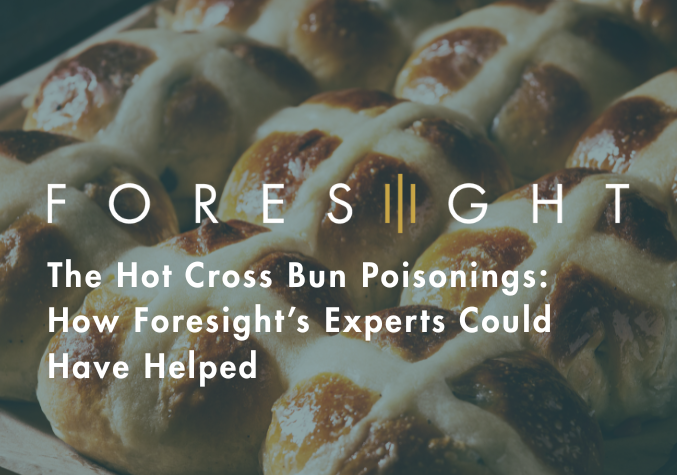News

Apr 11, 2025 by Foresight
The Hot Cross Bun Poisonings: How Foresight’s Experts Could Have Helped
Food safety measures may be something we take for granted today, but in the past, it wasn’t always guaranteed, with one of the most infamous cases of mass food poisoning in the UK occurring on Good Friday 1882, when 147 people in Inverness fell severely ill after eating contaminated hot cross buns.
This shocking incident is now known as the Inverness Hot Cross Bun Poisonings and was eventually traced back to accidental arsenic contamination at a local bakery. Whilst fortunately no one died as a result, the event was a stark reminder of the dangers posed by poor food safety practices.
But, had Foresight’s expert witnesses and forensic specialists been available at the time, they could have played a critical role in investigating the case, identifying the cause and ensuring justice was served.
How exactly could modern forensic science and expert analysis have helped?
Let’s take a closer look.
The Role of Toxicologists in Identifying the Poison
In 1882, forensic toxicology was still in its infancy, and while scientists could test for arsenic using the Marsh test, it wasn’t a standard procedure in food contamination cases. Today, however, Foresight’s toxicology experts would have been able to swiftly analyse the chemical composition of the hot cross buns to confirm the presence and quantity of arsenic.
Using modern forensic techniques such as mass spectrometry and chromatography, experts would have identified the precise source of contamination, and this would have helped authorities understand whether the poisoning was due to deliberate tampering or an accidental mix-up, which was a crucial question in the original investigation.
Food Safety Experts and Investigative Failures
At the heart of the Inverness incident was a critical failure in food handling whereby the bakery mistakenly used arsenic instead of a harmless ingredient, likely due to poorly labelled containers. Today, food safety and public health experts from Foresight would have been instrumental in identifying regulatory failures and providing recommendations on how such mistakes could be avoided in future.
Experts could have also examined workplace safety protocols, ingredient storage conditions, and employee training records to determine where the system failed. As such, their testimony could have influenced future legislation, much like similar cases in later years led to the tightening of food safety laws in the UK.
Forensic Document Examiners and Supplier Responsibility
In cases of food contamination, it’s crucial to trace the supply chain and identify accountability, and Foresight’s forensic document examiners could have helped determine where the arsenic originated, whether the supplier mislabelled it, or if record-keeping failures led to its misuse.
By examining handwritten invoices, supplier contracts and stock records, these experts could have provided evidence in legal proceedings to clarify responsibility too, and their findings might have determined whether the bakery was solely at fault or if the contamination issue extended further up the supply chain.
Medical Experts and Assessing the Impact on Victims
With 147 people falling ill, a medical expert witness would have been critical in assessing the extent of the poisoning’s impact, and in court cases today, medical experts provide crucial testimony regarding the long-term health consequences of foodborne toxins.
In this case, experts could have:
- Evaluated symptoms and diagnosed arsenic poisoning.
- Assessed whether victims suffered lasting health complications.
- Determined treatment protocols that could have mitigated harm.
- And provided expert testimony on the seriousness of the incident in a courtroom setting.
Criminal And Civil Liability
Once the cause of the poisoning was identified, legal experts would have been needed to determine who was responsible. Then, if the bakery had been negligent in handling ingredients, corporate responsibility and duty of care would have been key legal arguments, or if the contamination was due to a supplier error, liability could have shifted to a third party.
In this instance, Foresight’s legal experts in food contamination cases would have:
- Helped establish the chain of liability.
- Provided insight into historical and modern legal precedents for food safety violations.
- And assisted in ensuring appropriate compensation for victims.
Taking Lessons from The Past and Preventing Similar Incidents Today
The Hot Cross Bun Poisonings of 1882 were a wake-up call in an era with limited food safety regulations, and thankfully, incidents like this have become far rarer due to stricter legislation, better training, and forensic advancements. However, food contamination does still occur whether due to negligence, supply chain failures or criminal tampering.
Today, Foresight’s experts provide essential support in cases where public health is at risk, in all areas from toxicology analysis and forensic auditing to expert testimony in court, their involvement ensures that justice is served, and future risks are minimised.
But whilst we can’t change history, modern forensic science and expert analysis ensure that mistakes like the Inverness Hot Cross Bun Poisonings are far less likely to happen again. And if they do, Foresight’s team is here to help.
If you would like to talk to our team about instructing one of our Foresight experts, please get in touch.
FIND YOUR
EXPERT WITNESS
CALL OUR TEAM ON
0330 088 9000
NEWSLETTER SIGN-UP
Stay up-to-date with all the latest news in the industry by signing up to our newsletter. You're welcome to unsubscribe at any time and we'll always treat your personal details with the utmost care.

